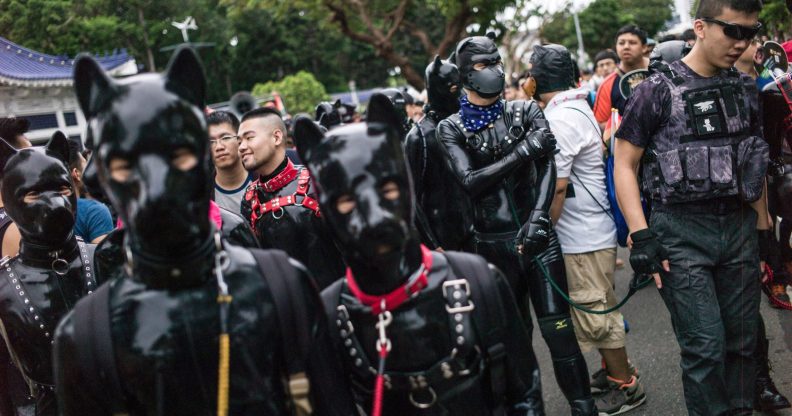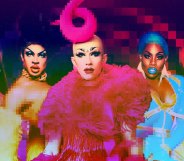Pride parades are cancelled but the discourse on kink at Pride refuses to go away

Leather pups at Tapei Pride in Taiwain. (Getty)
Pride parades have been cancelled this year, but that hasn’t stopped the annual discourse around what is appropriate from taking place.
Pride Month 2020 is the first in recent memory not to be marked by worldwide parades and festivities, thanks to the coronavirus pandemic putting the kibosh on large gatherings.
Though the LGBT+ community has been robbed of an opportunity to gather in celebration and protest, many will have been relieved at the idea of missing a full year of Pride Month discourse.
As it turns out, they weren’t so lucky.
A viral tweet depicting a man wearing a bandana tied strategically around one leg sparked yet another debate on whether nudity, kink and fetish have a place at Pride.
Those against can be split into two distinct camps: homophobes looking for an excuse to rabidly decry the validity of Pride, and those with genuine concerns about how Pride can be inclusive for all.
A hyperbole-filled tweet defending the right to “wear a jockstrap” to Pride and “get f**ked against a recycling dumpster” prompted a barrage of angry replies.
“No, it’s every queer person’s space and that includes children,” said one critic. “Also Pride isn’t about sex, that’s not all there is to queerness.”
https://twitter.com/privsafian/status/1270792728645943298
On the other side of the debate are the many who decry the judgement of queer bodies and identities.
“Pride is not a place for you to police people’s sexuality and tell them they can’t show skin in public because you want to bring children to a public celebration of sex and sexuality,” tweeted one advocate. Others have pointed out the homophobia that is often evident in criticism of queer bodies, and questioned the relevancy of the debate considering the current climate.
If your pride isn’t sex, kink, and fetish positive it’s not pride
— Jason Rosenberg (@mynameisjro) June 10, 2020
https://twitter.com/CerruleonRose/status/1270806599758741505
https://twitter.com/iamtheaardvark/status/1270830137760571392
Can we redirect all of that 'no kinks at Pride' energy into 'no cops at Pride' instead?— Erin Ekins (she/her) (@QueerlyAutistic) June 11, 2020
One New York leather pup told PinkNews that for him, there’s no separating his sexuality from his kink.
“I’m a gay man identifying as a pup, who has embraced a ‘no-shame’ approach to sex and love and self expression,” said Pup Champ.
“If I want to wear a jockstrap and a harness and a pup hood, I’m going to do so. If parents want to bring their kids to a pride event, they can educate their children on what they are experiencing, wait until those children are old enough to make informed decisions for themselves, or stick to the family/kid safe events.
“Pride isn’t just rainbows and glitter and vodka soda while a bop plays, it was started as a riot. It’s a safe space for being gay and self expression.”
As many have noted, there are major flaws in the argument that bringing kink to Pride is a violation of consent. “There are absolutely degrees of sexuality,” tweeted one transgender lesbian, @FinalBossFemme, pointing out that seeing somebody wearing leather is quite far removed from having a sexual interaction with them.
“Obviously people having public sex is not okay, but kink is a massive part (though not the whole part and not for everyone) of queer identity and it’s not because people want to have public sex.”
I cannot believe the “ no kink at pride “ people are coming out swinging THIS June of all years
-Kink is part of pride
-Nobody is out there fuckin
-Minors are not stupid, they understand what they’re seeing. If they don’t then it’s your job as a parent to explain it— soma🌸 (@FinalBossFemme) June 11, 2020
For some, this entire debate is moot. The stigma that remains around kink means that sometimes, being out and proud about it can represent a threat to a person’s safety or livelihood.
One man told PinkNews that his day job in teaching prevents him from marching with his local fetish community. He has cultivated an entirely separate internet persona for his kink that he keeps separate from his day-to-day life, and instead waves his friends on from afar.
“It’s hard for me be open and honest,” he said, noting that he is aware of others who have lost jobs on account of their kinks being made public.
“When I’m at events, people know who I am and I’m happy to interact, but I’m scared to put anything online. I suppose it’s the thought that teachers’ standards outline anything that may bring the profession into disrepute. It’s not illegal nor a safeguarding issue, but I imagine it to be frowned upon.”
Though he is proud of his friends who do march in rubber and leather – and “look fierce” doing it – he believes there is a balance to be found. In the context of a Pride parade, he believes things should be “maintained at a PG level – nothing too raunchy”.
People insisting that it’s their right to get “f**ked over a bin” feels like the wrong message, he added, if the aim is to win over would-be advocates to the community.
Fetish and Pride have an interwoven history.
As many have pointed out, Pride would not exist without members of the kink and fetish community, who have been at the forefront of the fight for LGBT+ rights.
As one Twitter user with experience organising Pride events noted: “The queer fetish community should not be erased from our history.”
3. Freedom in nudity and overt sexualisation are NOT the same thing.
Also wearing fetish gear to pride and participating in sexual kink play in public are not the same thing.
The queer fetish community should not be erased from our history.
— BLACK LIVES MATTER (@HanabiDrift) June 11, 2020
One of the names that crops up most often when this discourse rears its head is that of Brenda Howard, a bisexual activist, sex-positive feminist and unabashed leather fetishist.
Howard is known to many as the “Mother of Pride” for the vital part she played in organising the Christopher Street Liberation Day Parade – the first ever Pride.
Much of Howard’s work focused on inclusion: she was partially responsible for adding “Bi” to the title of the 1993 March on Washington for Lesbian, Gay and Bi Equal Rights and Liberation, attend by more than 1 million people, where she served as a co-chair of the leather contingent.
Howard also fought for the inclusion of people of colour and people living with HIV in the larger LGBT+ rights movement.
“She was an in-your-face activist,” her partner, Larry Nelson said in 2014, nine years after she passed away. “She fought for anyone who had their rights trampled on.”
Members of the leather community were also among the first to respond to the AIDs crisis when it began in the early 1980s, caring for the sick when others were afraid to touch them, raising funds and advocating.
As one leatherman told the HIV Story Project in 2015: “The leather community was just as scared and uninformed as anybody else.
“The different was being marginalised creatures anyway we weren’t afraid to get in the trenches.”

